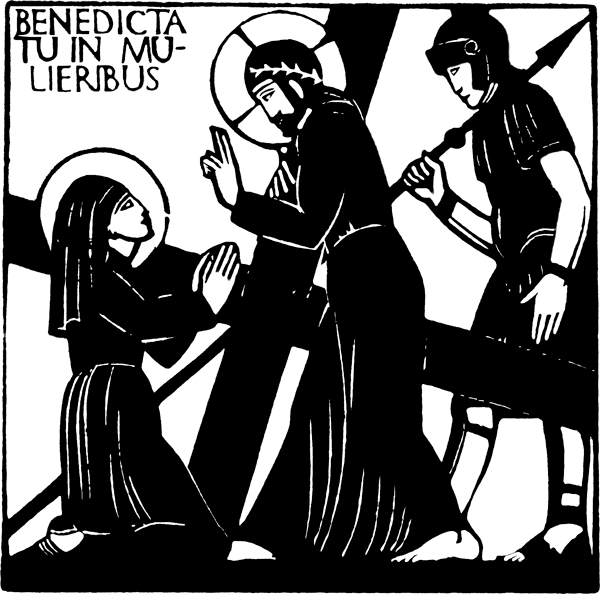Jesus meets his mother

Mary
“O my son, my dear son. It was agony to see you suffering like this. How many mothers have seen their children suffer? I knew what it was like. We, my friends and I, had waited outside the governor’s palace, waiting for you to be freed. And then the soldiers forced you out, carrying a cross. Before they could stop us we ran past them and hugged you. Why was this happening to you? Why? Surely you could have said something, done something, and it would have stopped? Even now? But as he looked at me, I knew this would not happen — I felt as if a sword had pierced my heart.”
Prayer
Lord Jesus, your mother Mary wept at your torment:
give heart to all parents who watch their children suffer.
Your mother felt your pain in her heart:
guide us to bring the fullness of life to children and parents.
To you, Jesus, Son of God and Son of Mary,
be honour and glory with the Father and the Holy Spirit,
now and for ever.
Amen.
illustration: from a wood-engraving by Eric Gill, 1917
Seeing Eric Gill’s work used for devotional practice makes me reflect on how far the work of deeply flawed people still holds value. Gill abused his children (which was only discovered after his death when his biographer read his diaries), and for some people, this could make his work inappropriate. Given that his most prevalent creation (Gill Sans) is used to typeset Common Worship, and is therefore present in virtually Anglican Parish Church, this is a vital question to be clear on. The Mennonite Church has a similar dilemma regarding the works of John Howard Yoder, the seminal ethicist who… Read more »
Jeremy: this is a really important question, and I did anticipate someone asking it when I chose to use Gill’s engravings. It’s the same issue faced by the authorities in Westminster Cathedral with regards to the Stations carved there by Gill too. All sorts of things down the ages have been created as a result of oppression. The Pyramids were built by slave labour. The glories of ancient Rome were built on conquest, the glories of renaissance Rome built on the territorial rule of the Popes, not to mention the sale of indulgences. Should we remove Michelangelo’s paintings from the… Read more »
In his excellent Lent book, A Season of Rebirth, Marc Foley addresses this question. he invokes the teaching of ex opere operato and says: ‘We may not like the instrument that God chooses to speak truth to us. In fact, he or she may be our enemy…Worldly wisdom tells us to ‘consider the source.’ Conversely, however, St Thomas tells us that we must consider what a person says and not who says it. Even if the devil were to speak to us, if he spoke the truth, we should attend to what he says.’
…and I would add the obvious reference to Article 26, that the unworthiness of the minister does not hinder the effectiveness of the sacrament. Yes, that’s about clergy and sacraments, but surely the principle is the same. Given that we all sin and fall short of the glory of God, then if the sinfulness of the artist somehow taints the art, we would have to expunge the world of all art. It’s only a matter of degree, and not kind.